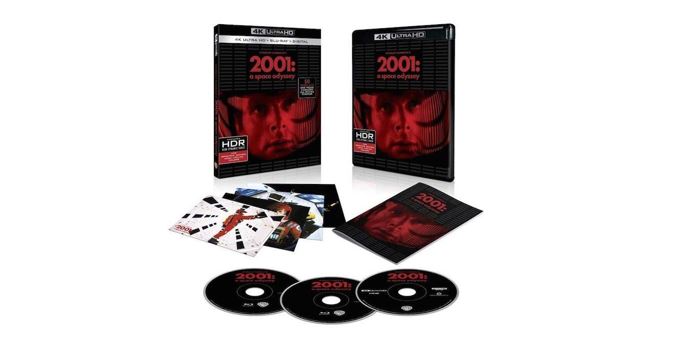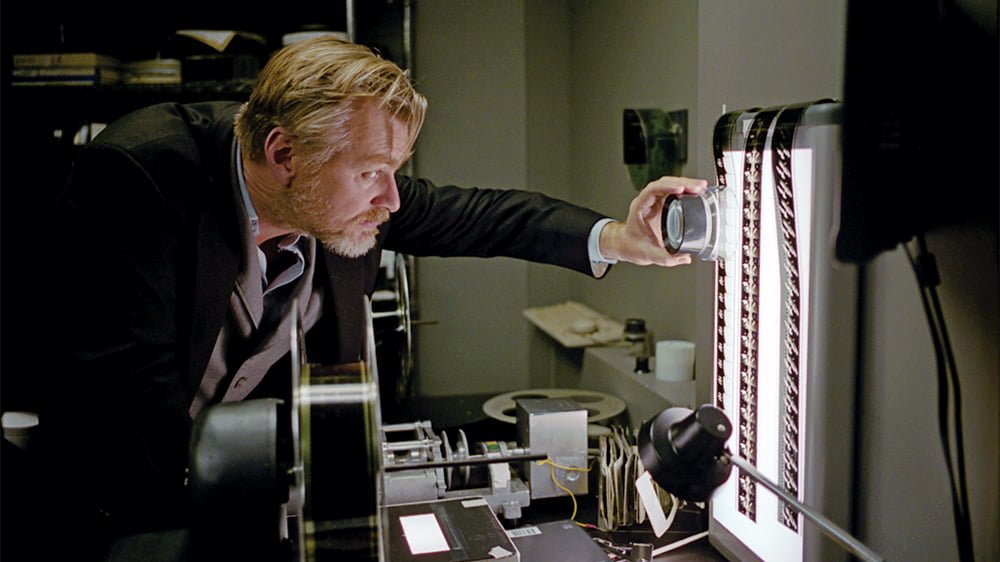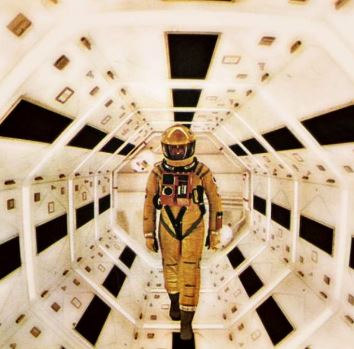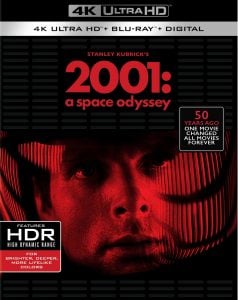 Every film fan has their favorites, a list of movies they can watch endlessly. The film might be a comedy, a drama or an action film, but they’ve become “feel good” movies where you have positive associations with both the film and your previous viewings. More serious film fans, however, also have films that they enjoy because of how profound they are or because they’re just so masterfully assembled, true examples of visual storytelling.
Every film fan has their favorites, a list of movies they can watch endlessly. The film might be a comedy, a drama or an action film, but they’ve become “feel good” movies where you have positive associations with both the film and your previous viewings. More serious film fans, however, also have films that they enjoy because of how profound they are or because they’re just so masterfully assembled, true examples of visual storytelling.
The science fiction epic 2001: A Space Odyssey is a milestone in the history of cinema that rewards viewers who pay attention to both the deep and profound story and how it’s told visually on screen. Directed by Stanley Kubrick based on a book by Arthur C. Clarke, 2001 was first released in 1968, one of the highest budget sci-fi films in the history of cinema. Shot in 65mm Cinerama, the sweeping epic calls to mind the great David Lean (Lawrence of Arabia) when it’s on Earth, but the visual effects and obsessive, visionary details were truly revolutionary back in the 1960s.
 Warner Bros Entertainment and MGM worked with film preservationist Vince Roth to create a new 70mm print, with the help of Christopher Nolan (Inception, Interstellar). The scanning and recoloring process began in 1999 and it’s only in the last few weeks that the 4K Ultra HD remaster release of 2001: A Space Odyssey has finally become widely available. It took that long to properly restore all elements of this 2 1/2 hour masterpiece of sci-fi cinema.
Warner Bros Entertainment and MGM worked with film preservationist Vince Roth to create a new 70mm print, with the help of Christopher Nolan (Inception, Interstellar). The scanning and recoloring process began in 1999 and it’s only in the last few weeks that the 4K Ultra HD remaster release of 2001: A Space Odyssey has finally become widely available. It took that long to properly restore all elements of this 2 1/2 hour masterpiece of sci-fi cinema.
Let’s start with the film itself. 2001: A Space Odyssey tells the story of the evolution of mankind from primitive simian to space-going humanity to becoming a consciousness beyond the constraints and confines of our planet. What makes it so fascinating is that these evolutionary jumps are due to alien intervention through the appearance of mysterious black obelisks. In the first act, it’s the overnight arrival of an obelisk that inspires one of the primitive apemen to pick up and wield a bone as a tool. A tool that gives him almost instant mastery over his environment in a way that’s a clear leap forward. Then, in one of the most famous cinematic transitions in movie history, the bone is hurled into the air and switches to a satellite floating in space. We’ve jumped forward thousands of years in the narrative and in human evolution both.
An obelisk has been discovered on the moon, a planetary satellite we have long since colonized. Dr. Heywood Floyd (William Sylvester) has been brought up from Earth to advise the scientists on the meaning of their discovery, though it’s shrouded in the greatest secrecy. He arrives at a massive orbiting space station complete with Pan-Am, Hilton and Howard Johnson facilities and an AT&T video phone that lets him chat briefly with his daughter [Kubrick’s young daughter in real life] before the big meeting begins. The obelisk, known as TMA-1, has been buried for millions of years and was found due to its unique and inexplicable magnetic signature. They eventually hop into a shuttle and fly across the lunar surface to visit the excavation site, triggering a signal from the obelisk out into deep space.
Jump forward 18 months to the Jupiter mission: A spaceship, The Discovery, has been built to investigate where the obelisk signal was beamed. This ship is crewed by six: three scientists are in deep sleep in cryo-units and two of the astronauts are awake to tend the ship: Dr. Frank Poole (Gary Lockwood) and Commander Dave Bowman (Keir Dullea). The ship itself is controlled by the HAL 9000 computer system, a completely infallible system that has a distinct personality and chats constantly with the astronauts.
 In a perhaps ironic statement on evolution and consciousness, HAL turns out to have some quirks and problems of his own. He identifies a communications component, the AE-35 unit, as showing signs that it’s going to have a catastrophic failure in the next 48 hours. But when the astronauts leave the ship to inspect the part, there’s nothing wrong. Is HAL fallible? And what does that mean to the mission?
In a perhaps ironic statement on evolution and consciousness, HAL turns out to have some quirks and problems of his own. He identifies a communications component, the AE-35 unit, as showing signs that it’s going to have a catastrophic failure in the next 48 hours. But when the astronauts leave the ship to inspect the part, there’s nothing wrong. Is HAL fallible? And what does that mean to the mission?
There’s lots more to the movie, but to me, it’s not so much the story that’s so compelling about 2001: A Space Odyssey as the look and sound of the movie. To say it’s one of the most breathtaking sci-fi films ever made might understate the case, and when Chris Nolan opted to start Interstellar with its gorgeous landscape shots, it’s 2001 he’s acknowledging.
It’s the visual components where the 4K restoration really shines, and watching it on a full 4K setup, with Vizio 4K television and Samsung 4K Blu-Ray player, left me relishing the crystal clear, beautiful, photo-quality imagery.
When Warner set out to release a 4K remaster of 2001: A Space Odyssey, their goal was to duplicate the cinematic experience at home. I’ll just quote Chris Nolan: “4K UHD allows the closest recreation of viewing the original film print in your own home.” He also refers to 2001 as “the most cinematic film that has ever been made”, in case you want confirmation of its profound importance in cinematic history.
The 4K UHD release itself might seem a bit lacking in special features compared to modern movies where they have a second crew prepping the behind-the-scenes footage from day one. If you’re looking for documentaries on the making of the film or how the special effects were produced, you’ll be disappointed. The release includes three audio tracks (original 6-track theatrical audio, 5.1 DTS remastered audio track, and a commentary track that’s quite fascinating) and not much else. It’s all about the movie.
 There is a Premium Packaging version of the 4K UHD release from Warner Bros that does include a Blu-Ray disk with additional extras, but that wasn’t in the box the studio sent me to review. I don’t mind, however, because 2001: A Space Odyssey absolutely speaks for itself, and the crisp, vibrant and stunning visuals, the famous Strauss soundtrack and the consistently excellent performances from the cast add up to a splendid remaster of a film that every true sci-fi fan should own and watch regularly. This is how it’s done.
There is a Premium Packaging version of the 4K UHD release from Warner Bros that does include a Blu-Ray disk with additional extras, but that wasn’t in the box the studio sent me to review. I don’t mind, however, because 2001: A Space Odyssey absolutely speaks for itself, and the crisp, vibrant and stunning visuals, the famous Strauss soundtrack and the consistently excellent performances from the cast add up to a splendid remaster of a film that every true sci-fi fan should own and watch regularly. This is how it’s done.
I should warn younger fans, however, that Kubrick makes you work to appreciate 2001: A Space Odyssey. Sequences are long, shots are leisurely paced and actions unfold gradually on screen. Some sequences (notably the last portion of the film) could perhaps have been tightened up a bit to shorten the film. But let Kubrick set the pace with the film instead of getting impatient. Block out the 2 1/2 hours, take a deep breath, mute your phone, lower the lights and let yourself be pulled into the story and visual tale of the film. It’s very much time well spent.
“2001: A Space Odyssey” 4K UHD Release on Amazon: $33.07 or the full premium package version for $64.99. Released by Warner Brothers Home Entertainment.
![]()
